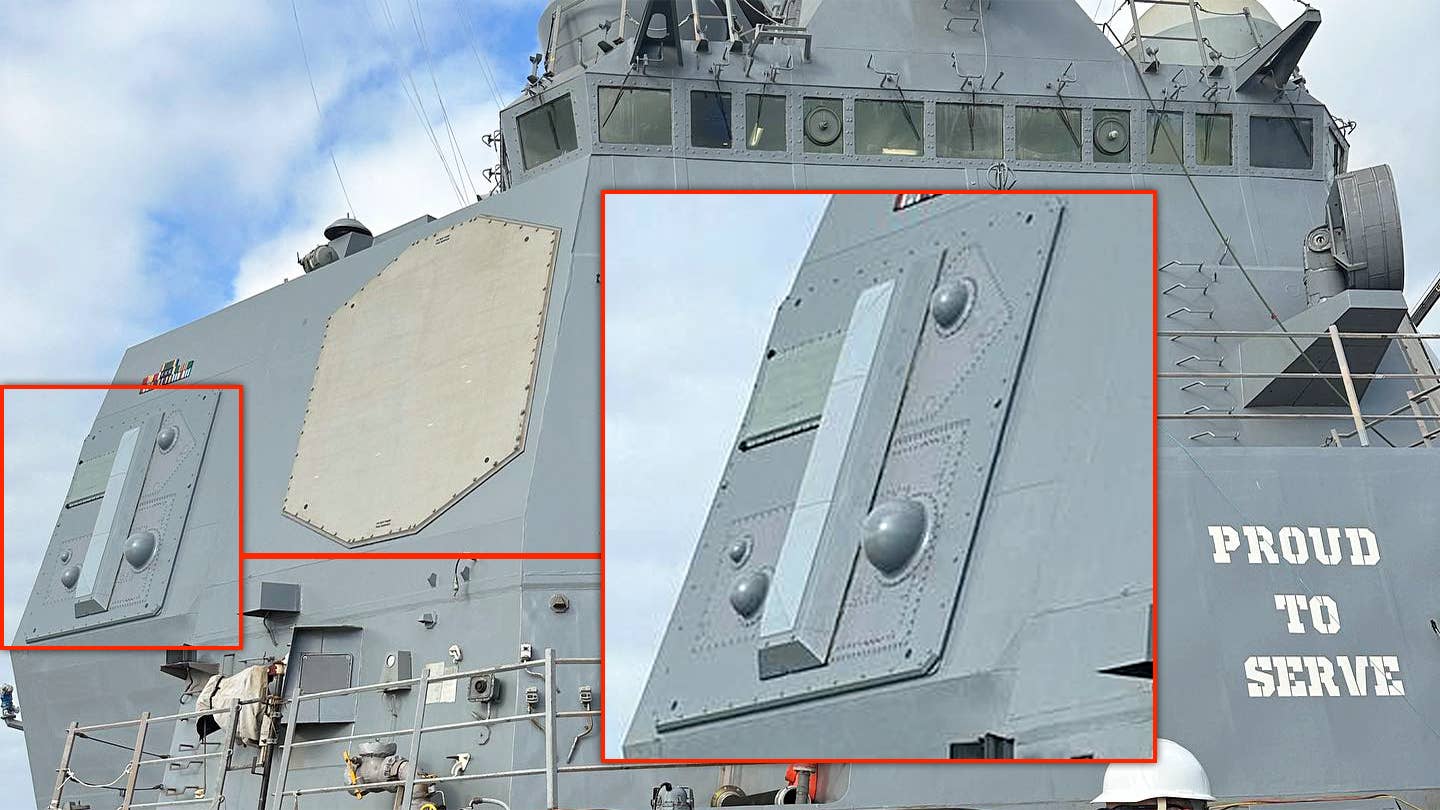The SEWIP Block III alters the Arleigh Burke destroyer’s appearance fairly dramatically via huge new extensions onto its superstructure.

New pictures show what we have long anticipated — the new AN/SLQ-32(V)7 Surface Electronic Warfare Improvement Program (SEWIP) Block III’s dramatic impact on U.S. Navy Arleigh Burke class destroyers’ contours. USS Pinckney (DDG-91) is the first of the Burkes to get SEWIP Block III, which is a revolutionary electronic warfare upgrade for these vessels, that you can read all about here.
Photographs of Pinckney, a Flight IIA Arleigh Burke subvariant, sporting the SEWIP Block III were posted on the ship’s official Facebook page recently.
One portion of USS Pinckney‘s new SEWIP Block III electronic warfare system can be seen at the left in this picture, outboard of the octagonal radar array. The ship’s motto, “Proud To Serve,” is also seen written on the front of the superstructure. USN
The new electronic warfare system and other upgrades were installed on the ship as part of a regularly scheduled maintenance period that lasted around two years. The ship left drydock at General Dynamics NASSCO’s yard in San Diego, California, in August, but it is unclear if it has formally returned to service.
Externally, the biggest change that comes with installing SEWIP Block III on an Arleigh Burke class destroyer is the complete reworking of the sides of the main superstructure. Two huge, geometric, fully enclosed extensions are fitted in place of what had been open platforms and attachment points.
Another look at USS Pinckney with the new SEWIP Block II system installed. USN
The exact dimensions of these new structures are unknown, but developmental examples of core elements of the enclosures were around 22 feet tall by themselves.
A developmental SEWIP Block III module on a test rig on the ground. The system’s installation on Arleigh Burke class destroyers includes one modules on either side of the main superstructure. Northrop Grumman
Early SEWIP Block III concept art, seen below, had given some sense of what the final fit would look like. However, in hindsight, these renderings majorly downplayed just how significantly the ship’s outward appearance would change as a result of the upgrade.
Northrop Grumman
Northrop Grumman
Later concept art gave a clearer idea of what the installation would look like and how SEWIP Block III’s four arrays would change the mold-line of the ship permanently.
Updated concept art showing the large geometric extensions on both sides of the forward superstructure. USN
Previous SEWIP systems used on Arleigh Burke class ships, such as the variant previously installed on the USS Pinckney, feature much SEWIP hardware smaller modules mounted externally on platforms on either side of the ship’s main superstructure. The bridge wings jut out above these platforms.
With SEWIP Block installed, this whole area has been enclosed and blended, including around the gunwale below. It definitely beefs up the beam of the ship and results in a weightier-looking superstructure. It’s also easy to see how the extra space will lend itself to configuration changes and other SEWIP upgrades and expansions in the future.
One of the older SEWIP modules that was previously found on the USS Pinckney can be seen here on a platform on the right side of the main superstructure below the bridge wing. USN
A closer look at an older SEWIP system module on an Arleigh Burke class destroyer. USN
The addition of SEWIP Block III to the ship is a significant development beyond just the significant changes to its outward appearance, as The War Zone‘s Tyler Rogoway has written in the past:
“This system combines the advanced passive detection capabilities of SEWIP Block II with the ability to make active, powerful, and highly precise electronic attacks on multiple targets at once. Beyond its core functionality, it can do much more, as well, including acting as a communications node and even a radar system. It is also designed to be able to be upgraded for decades to come. So, we are talking about a quantum leap not just in defensive, but also offensive electronic warfare capability for the Navy’s surface fleet.”
There has also already been talk of SEWIP Block III subvariants or derivatives with different form factors, including ‘lite’ versions that are suitable for installation on smaller ships and ones with less power-generating capacity than an Arleigh Burke class destroyer. The capabilities of those systems would, of course, also be more limited than the full-up version.
As of January, the Navy was planning to add SEWIP Block III to some 20 Flight IIA Arleigh Burke class destroyers, according to USNI News. Other major upgrades for those ships are also expected, including new AN/SPY-6(V)4 radars, which you can read more about here.
Interestingly, the service’s first Flight III Arleigh Burke, the USS Jack H. Lucas, does not have SEWIP Block III, or a subvariant or derivative thereof, but one would imagine other ships in this class might be fitted with it down the line.
The first Flight III Arleigh Burke class destroyer, the USS Jack H. Lucas, which features the older SEWIP Block II electronic warfare system. HII
Whatever the case, the pictures of USS Pinckney make clear that Burkes fitted with SEWIP Block III will be very easy to tell apart from other ships in this class.
Contact the author: joe@thedrive.com



